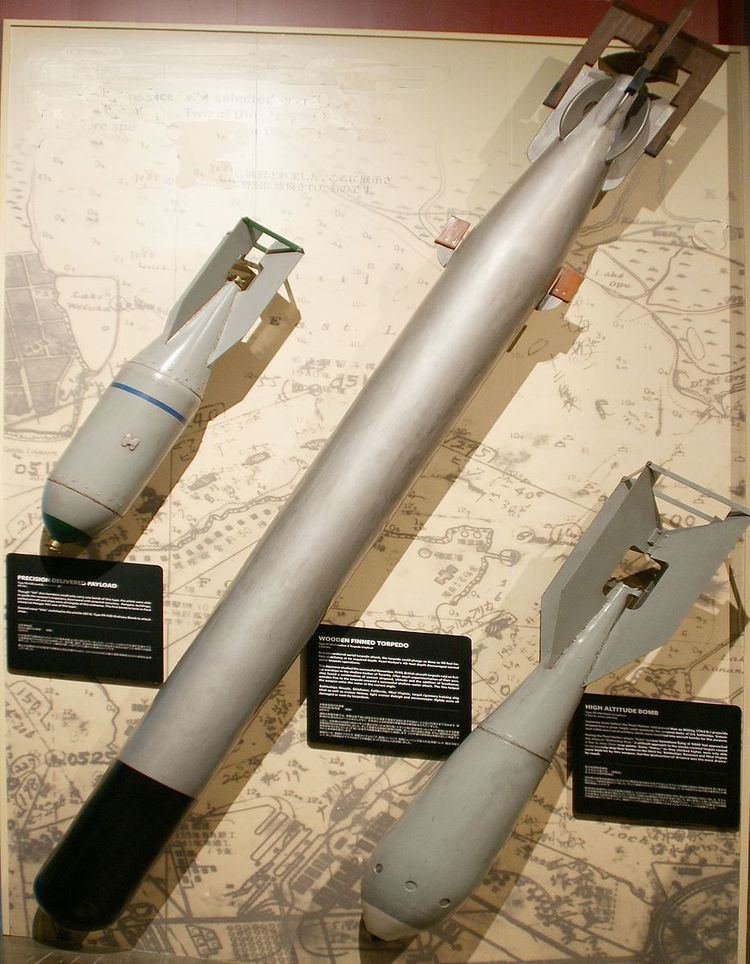This is a complete list of all aerial bombs used by the Imperial Japanese Navy during the Second World War.
The Japanese navy produced a large number of different types of bombs, these were sub-divided into three main categories:
Land bombs - for use against land targets. They were normally not produced to a high standard consisting of a simple cylindrical case, riveted or welded to a cast steel nose.Ordinary bombs - for use against ships. They were produced in general purpose and semi-armor-piercing types. They were of higher quality and generally had a smooth machined caseSpecial bombs - for various purposes.The Japanese produced a number of bombs with rocket motors installed, intended for air-to-air use against bomber formations, or as armor-piercing weapons. Only two saw service, the Type 3 No.25 Mk 4 armor-piercing rocket bomb, and the Type 3 No.6 Mk.27 air-to-air rocket bomb.
Type 99 No.3 Mk 3Type 3 No.6 Mk 3 bomb model 1Type 2 No.25 Mk 3 bomb model 1Type 98 No.7 Mk 6 bomb model 1Type 98 No.7 Mk 6 bomb model 2Type 1 No.7 Mk 6 bomb model 3 mod 1No. 6 Mk 1Type 1 No.6 Mk.1Type 4 No.6 Mk 1Type 2 No.6 Mk 21 bomb model 1Type 2 No.6 Mk 21 bomb model 21 kg hollow-charge bomb1 kg anti-personnel bomb1 kg Practice bomb Mod 21 kg Practice bomb Mod 3No.3 Practice bomb Model 1Type 99 No.3 Practice bombType 96 landing flareLanding flare5 kg parachute flare Model 2 mod 1Type 0 parachute flare Model 1Type 0 parachute flare Model 1 mod 1Type 0 parachute flare Model 2Type 0 parachute flare Model 3 mod 1Experimental model 11 parachute flareType 94 float lightExperimental float lightType 94 model 2 float lightType 0 model 1 float lightSmoke floats and markers
2 kg smoke float43 kg smoke floatType 0 Model 1 sea markerType 0 Model 2 sea markerCardboard type sea markerType 3 No.6 target marker bombType 2 2 kg target indicator2 kg Window (Chaff) bombJapanese Navy bomb fuzes designation system was unknown to the Allies until after the end of the Second World War. As a result, a designation system was created to describe the fuzes as follows. It consists of a capital letter, a numeral and a lower-case parenthetical letter.
The capital letter designates the fuzes type as follows:
A - nose impactB - tail impactC - long delay fuzeD - airburst fuzeE - protective fuzeThe numeral approximates the order in which the fuzes were captured by the allies. Finally the lower-case letter in parentheses indicates the different but similar designs.
Where possible the original Japanese designation is given.
A-1(a)A-1(b)A-1(c)A-3(a) Type 97 Mk 2 nose fuzeA-3(b) Type 1 nose fuze model 2A-3(c) Type 2 nose indicatorA-3(d) Type 97 Mk 2 nose fuze Model 1A-3(e) Type 3 nose indicatorA-3(f) Type 2 No.50 Ordinary bomb fuze model 1A-3(g)A-5(a)B-2(a) Type 99 No.25 Ordinary bomb fuzeB-2(b) Type 99 No.80 Mk 5 Bomb fuzeB-3(a) Type 15 tail fuze model 2B-3(b) Type 15 tail fuze model 1B-5(b)B-5(c)B-6(a) Type 97 rail initiatorB-9(a) tail fuzeB-10(a) tail fuzeC-1(a) Type 99 special bomb fuzeC-2(a) Type 99 special bomb nose fuzeD-2(a)D-2(b)D-2(c)D-3(a)D-4(a) parachute flare fuzeType 3 electric firing device
